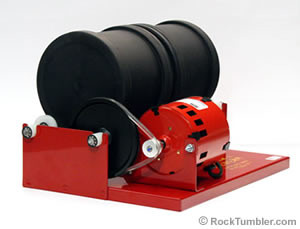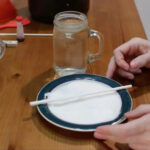Do you want to transform rough rocks into dazzling gemstones? How long rock tumblers take depends on several factors, but at rockscapes.net, we’ll guide you through the process to achieve stunning results. Understanding the nuances of rotary and vibratory tumblers, the type of rocks you’re working with, and the grit you use will help you master the art of rock tumbling and create beautiful polished stones.
1. What is the Average Rock Tumbling Time?
The average rock tumbling time can range from one week to over a month, depending on the type of tumbler, the hardness of the rocks, and the desired level of polish. Rotary tumblers typically require 4-8 weeks for a complete cycle, while vibratory tumblers can achieve similar results in 1-2 weeks.
1.1. Why Does Rock Tumbling Time Vary?
Several factors influence the duration of the rock tumbling process. Understanding these factors will help you optimize your tumbling schedule and achieve the best possible results.
- Type of Tumbler: Rotary and vibratory tumblers have different mechanisms and speeds, affecting the overall tumbling time.
- Rock Hardness: Softer rocks tumble faster than harder rocks.
- Grit Size: Different grit sizes are used in each stage of the tumbling process, each requiring a specific duration.
- Desired Finish: The level of polish you want to achieve will also influence the tumbling time.
- Rock Size and Shape: Larger and more angular rocks may require longer tumbling times to achieve a smooth, rounded shape.
2. How Long Does Rock Tumbling Take with a Rotary Tumbler?
Rotary tumblers are the most common type of tumbler used by hobbyists. They work by slowly rotating a barrel filled with rocks, water, and abrasive grit. This process gradually grinds down the rough edges of the rocks, smoothing and polishing them over time.
2.1. What are the Stages of Rotary Rock Tumbling?
Rotary rock tumbling typically involves four stages, each with a specific grit size and duration:
- Coarse Grind: This initial stage removes the rough edges and shapes the rocks. It typically lasts 7-10 days.
- Medium Grind: This stage further smooths the rocks and removes any remaining imperfections. It usually takes 7 days.
- Fine Grind (Pre-Polish): This stage prepares the rocks for the final polishing stage. It generally lasts 7 days.
- Polish: This final stage gives the rocks their shiny, polished finish. It typically takes 7 days.
2.2. What are the Tips for Rotary Tumbling?
To achieve the best results with a rotary tumbler, consider these tips:
- Use the Correct Grit: Using the wrong grit size can damage your rocks or prolong the tumbling process. Always follow the manufacturer’s instructions.
- Check the Rocks Regularly: Inspect the rocks after each stage to ensure they are progressing as expected.
- Clean the Barrel Thoroughly: Remove all traces of grit and mud between stages to prevent contamination.
- Maintain the Tumbler: Regularly clean and lubricate the tumbler to ensure it operates smoothly and efficiently.
- Use Proper Rock to Water Ratio: Generally, the rock to water ratio should be 2/3 rock and 1/3 water.
 Rotary rock tumbler, showcasing a Thumler's A-R2 with two three-pound barrels, commonly used for transforming rough rocks into polished stones.
Rotary rock tumbler, showcasing a Thumler's A-R2 with two three-pound barrels, commonly used for transforming rough rocks into polished stones.
3. How Long Does Rock Tumbling Take with a Vibratory Tumbler?
Vibratory tumblers use a different mechanism to polish rocks. Instead of rotating a barrel, they vibrate a bowl filled with rocks, water, and grit. This vibration causes the rocks to rub against each other, smoothing and polishing them much faster than a rotary tumbler.
3.1. What are the Stages of Vibratory Rock Tumbling?
Vibratory rock tumbling typically involves three stages:
- Medium Grind: This stage smooths the rocks and removes imperfections. It usually takes 3-7 days.
- Fine Grind (Pre-Polish): This stage prepares the rocks for the final polishing stage. It generally lasts 2-3 days.
- Polish: This final stage gives the rocks their shiny, polished finish. It typically takes 2-3 days.
3.2. What are the Advantages of Vibratory Tumblers?
Vibratory tumblers offer several advantages over rotary tumblers:
- Faster Tumbling Time: Vibratory tumblers can polish rocks in as little as one week, compared to the 4-8 weeks required for rotary tumblers.
- Less Rock Damage: The gentle vibration of the bowl minimizes the risk of chipping or cracking the rocks.
- Better for Delicate Rocks: Vibratory tumblers are ideal for polishing delicate rocks that may be damaged by the more aggressive tumbling action of a rotary tumbler.
- Preserves Angularity: Vibratory tumblers tend to smooth the rocks without significantly rounding them, preserving their natural angularity.
3.3. What are the Disadvantages of Vibratory Tumblers?
While vibratory tumblers offer several advantages, they also have some drawbacks:
- Higher Cost: Vibratory tumblers are generally more expensive than rotary tumblers.
- Less Rounding: Vibratory tumblers primarily smooth the rocks rather than rounding them, which may not be desirable for all users.
- Noise: Vibratory tumblers can be quite noisy during operation.
4. How to Combine Rotary and Vibratory Tumblers for Optimal Results?
Many experienced rock tumblers use a combination of rotary and vibratory tumblers to achieve the best possible results. This approach involves using a rotary tumbler for the initial shaping and smoothing stages, followed by a vibratory tumbler for the final polishing stage.
4.1. What are the Benefits of Combining Tumblers?
Combining rotary and vibratory tumblers offers several benefits:
- Faster Tumbling Time: This approach can significantly reduce the overall tumbling time compared to using a rotary tumbler alone.
- Excellent Rounding: The rotary tumbler ensures that the rocks are nicely rounded, while the vibratory tumbler provides a smooth, polished finish.
- Cost-Effective: By using a rotary tumbler for the initial stages, you can reduce the wear and tear on your more expensive vibratory tumbler.
4.2. How to Implement the Combined Approach?
To implement this approach, follow these steps:
- Coarse Grind (Rotary): Tumble the rocks in a rotary tumbler with coarse grit for 1-3 weeks to achieve the desired shape.
- Medium Grind (Vibratory): Transfer the rocks to a vibratory tumbler with medium grit for 3-7 days to smooth them further.
- Fine Grind (Vibratory): Use fine grit in the vibratory tumbler for 2-3 days to prepare the rocks for polishing.
- Polish (Vibratory): Finish the rocks with polish in the vibratory tumbler for 2-3 days to achieve a shiny, polished finish.
5. What Role Does Rock Type Play in Rock Tumbling Duration?
The type of rock you are tumbling significantly affects the time required for each stage. Softer rocks, like calcite, marble, and obsidian, tumble and polish much faster than harder rocks like jasper, agate, and quartz. This is because softer rocks are more easily abraded by the tumbling grit.
5.1. How to Adjust Tumbling Time Based on Rock Hardness?
To optimize your tumbling process, consider the hardness of the rocks you are working with:
- Softer Rocks (Mohs 3-5.5): Reduce the tumbling time in each stage by 50-75%. Monitor the rocks closely to avoid over-tumbling.
- Harder Rocks (Mohs 6-7): Increase the tumbling time in the coarse grind stage by 1-2 weeks to achieve the desired shape.
5.2. What is the Mohs Hardness Scale?
The Mohs Hardness Scale is a qualitative ordinal scale that characterizes the scratch resistance of various minerals through their ability to scratch harder materials. Developed in 1812 by German geologist and mineralogist Friedrich Mohs, it is one of the oldest and simplest methods for testing the hardness of a mineral. The test involves observing whether a material can scratch another material.
| Mohs Hardness | Mineral | Absolute Hardness | Example Material |
|---|---|---|---|
| 1 | Talc | 1 | Easily scratched by a fingernail |
| 2 | Gypsum | 3 | Scratched by a fingernail |
| 3 | Calcite | 9 | Scratched by a copper coin |
| 4 | Fluorite | 21 | Easily scratched by a knife |
| 5 | Apatite | 48 | Scratched by a knife |
| 6 | Orthoclase | 72 | Scratched by a steel file |
| 7 | Quartz | 100 | Scratches glass |
| 8 | Topaz | 200 | – |
| 9 | Corundum | 400 | – |
| 10 | Diamond | 1500 | – |
6. What Type of Grit Should You Use for Rock Tumbling and How Long to Tumble?
The type of grit you use is crucial for successful rock tumbling. Each stage of the tumbling process requires a specific grit size to achieve the desired results. Generally, the grit should be made of silicon carbide, as it is an extremely hard substance, and it is important to purchase the proper grit for rock tumbling, to avoid contamination.
6.1. What are the Different Grit Sizes and Their Uses?
The four main grit sizes used in rock tumbling are:
- Coarse Grit (60/90): Used for the initial shaping and grinding of rough rocks.
- Medium Grit (120/220): Used for further smoothing and removing imperfections.
- Fine Grit (500/600): Used for pre-polishing and preparing the rocks for the final polishing stage.
- Polish (8000-14000): Used for achieving a shiny, polished finish.
6.2. How Long to Tumble with Each Grit Size?
The tumbling time for each grit size depends on the type of tumbler and the hardness of the rocks. As a general guideline, follow these recommendations:
- Coarse Grit: 7-10 days in a rotary tumbler.
- Medium Grit: 7 days in a rotary tumbler or 3-7 days in a vibratory tumbler.
- Fine Grit: 7 days in a rotary tumbler or 2-3 days in a vibratory tumbler.
- Polish: 7 days in a rotary tumbler or 2-3 days in a vibratory tumbler.
6.3. What are the Common Issues With Rock Tumbling Grit?
Some common issues in maintaining grit for rock tumbling are:
- Contamination: It is vital to maintain grit properly in between tumbling, to prevent contamination that will affect future batches.
- Proper Storage: Grit needs to be stored in a sealed container in a dry place to keep from being contaminated.
- Proper Disposal: Silicon Carbide grit is not environmentally friendly. Proper disposal in a sealed container is needed to keep from contaminating water or soil.
7. How Does the Size and Shape of Rocks Impact Rock Tumbling Time?
The size and shape of the rocks you are tumbling also affect the tumbling time. Larger and more angular rocks may require longer tumbling times to achieve a smooth, rounded shape.
7.1. How to Prepare Rocks for Tumbling Based on Size and Shape?
Before tumbling, it’s essential to prepare the rocks properly:
- Sort Rocks by Size and Hardness: Tumble rocks of similar size and hardness together to ensure even abrasion.
- Break Down Large Rocks: Break down any large rocks into smaller, more manageable pieces.
- Remove Sharp Edges: Use a hammer or chisel to remove any sharp edges or points that could damage the tumbler or other rocks.
- Clean the Rocks: Wash the rocks thoroughly to remove any dirt, debris, or loose particles.
7.2. What are the Safety Precautions During Preparation?
Safety is paramount when preparing rocks for tumbling. Always wear safety glasses and gloves to protect your eyes and hands from flying debris. Work in a well-ventilated area to avoid inhaling dust.
8. What are the Ideal Environmental Conditions for Rock Tumbling?
The environmental conditions in which you tumble rocks can also affect the tumbling time and results. Ideally, you should tumble rocks in a cool, dry, and well-ventilated area.
8.1. How Does Temperature Affect Tumbling?
Extreme temperatures can affect the tumbling process:
- High Temperatures: High temperatures can cause the water in the tumbler to evaporate, reducing the effectiveness of the grit.
- Low Temperatures: Low temperatures can slow down the tumbling process and may even damage the tumbler.
8.2. Why is Ventilation Important?
Proper ventilation is essential to prevent the buildup of dust and fumes from the tumbling process. Work in a well-ventilated area or use a dust mask to avoid inhaling harmful particles.
9. How to Troubleshoot Common Rock Tumbling Issues?
Even with careful planning and execution, you may encounter some common rock tumbling issues. Here are some troubleshooting tips:
9.1. Why Are My Rocks Not Polishing?
If your rocks are not polishing properly, consider these factors:
- Insufficient Tumbling Time: Increase the tumbling time in the polish stage.
- Contaminated Grit: Ensure that the grit is clean and free of contaminants.
- Incorrect Grit Size: Use the correct grit size for the polish stage.
- Hard Water: Use distilled water to avoid mineral buildup.
9.2. Why Are My Rocks Chipping or Cracking?
Chipping or cracking can occur due to:
- Tumbling Rocks of Different Hardness: Tumble rocks of similar hardness together.
- Overloading the Tumbler: Do not overload the tumbler, as this can cause excessive impact.
- Using Too Much Coarse Grit: Reduce the amount of coarse grit used in the initial stage.
- Temperature Shock: Avoid exposing the rocks to sudden temperature changes.
9.3. Why Are My Rocks Not Rounding?
If your rocks are not rounding properly, consider these factors:
- Insufficient Tumbling Time in Coarse Grit: Increase the tumbling time in the coarse grind stage.
- Using Too Much Water: Use the correct water-to-rock ratio.
- Rocks Too Hard: Some rocks are naturally more difficult to round than others.
10. What are Advanced Techniques for Achieving a High-Quality Polish?
For those seeking to achieve a truly exceptional polish, consider these advanced techniques:
10.1. Burnishing
Burnishing involves tumbling the rocks in a mild soap solution after the polishing stage. This process removes any remaining grit residue and enhances the shine of the rocks. According to research from Arizona State University’s School of Earth and Space Exploration, burnishing can significantly improve the surface luster of polished stones by removing microscopic surface imperfections.
10.2. Using Ceramic Media
Adding ceramic media to the tumbler can help to cushion the rocks and prevent chipping or cracking. Ceramic media also helps to distribute the grit evenly and improve the overall polishing action.
10.3. What are the Polishing Compounds?
Some common polishing compounds used in rock tumbling are:
- Aluminum Oxide: This is the most common polishing compound and is suitable for most types of rocks.
- Cerium Oxide: This compound is effective for polishing softer rocks like glass and obsidian.
- Tin Oxide: This compound is used for achieving a high-gloss finish on hard rocks.
FAQ: Frequently Asked Questions About Rock Tumbling Times
1. How long does the coarse grind stage take in a rotary tumbler?
The coarse grind stage in a rotary tumbler typically takes 7-10 days, depending on the hardness and initial shape of the rocks.
2. Can I speed up the rock tumbling process?
Yes, using a vibratory tumbler can significantly speed up the rock tumbling process compared to a rotary tumbler. You can also combine both methods for faster and better results.
3. How often should I check my rocks during tumbling?
It is recommended to check your rocks after each stage to ensure they are progressing as expected and to identify any issues early on.
4. What happens if I leave my rocks in the tumbler for too long?
Leaving rocks in the tumbler for too long can result in over-rounding, chipping, or cracking, especially with softer rocks.
5. Can I tumble different types of rocks together?
It is best to tumble rocks of similar hardness and size together to ensure even abrasion and prevent damage.
6. What is the best type of tumbler for beginners?
Rotary tumblers are generally recommended for beginners due to their simplicity and lower cost.
7. How much does a rock tumbler cost?
Rock tumblers can range in price from $50 to $500 or more, depending on the type, size, and features.
8. Where can I buy rocks for tumbling?
Rocks for tumbling can be purchased online, at rock and mineral shows, or collected from natural sources.
9. How do I clean my rock tumbler?
Clean your rock tumbler with soap and water after each stage to remove grit and mud.
10. What are the safety precautions for rock tumbling?
Always wear safety glasses and gloves when handling rocks and grit. Work in a well-ventilated area and avoid inhaling dust.
Ready to transform ordinary stones into extraordinary gems? Visit rockscapes.net for expert advice, high-quality supplies, and inspiration for your next rock tumbling project. Whether you’re a beginner or an experienced hobbyist, we have everything you need to create stunning polished stones. Contact us at 1151 S Forest Ave, Tempe, AZ 85281, United States or call +1 (480) 965-9011. Start your rock tumbling journey today and uncover the hidden beauty within each stone with rockscapes.net.

